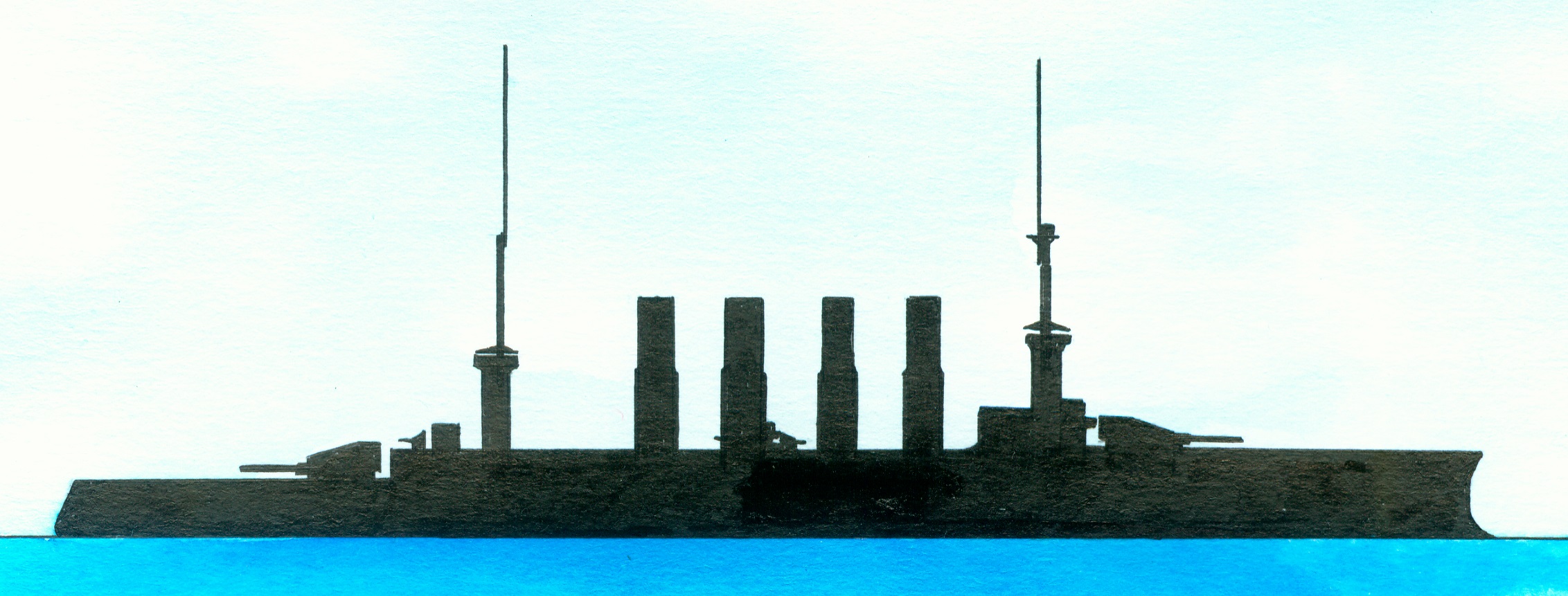A second item dated Petrograd, Russia 3rd claimed that in the mist a Russian squadron of cruisers meet east of Gotland 2 German light cruisers (1, 2) and some destroyers. Within short time begun the battle in which one German cruisers was heavily damaged, lowering the flag and stranded. The other German vessels retreated. One hour later started a second battle for 30 minutes between the Russians and the German cruiser Von Roon (3) supported by light cruisers and destroyers. The Germans retreated in southern direction and were strengthened by another light cruiser. When the Russian attacked again retreated the German vessels with higher speed. At 11.30 o'clock stopped the Russians with the purchase. Attacks by German submarines after the battle were without success. Russian losses were insignificant.
SMS Augsburg
Roon-class
The German version differs from the Russian. The Germans claimed that a small squadron returning from a reconnaissance on the Baltic Sea and came along the Russian squadron. The intention was to after an irregularly fight to lure the Russians waiting for more support. The loss of the Albatross was confirmed.
Notes
1. Minelayer cruiser of the Nautilus-class laid down at AG Weser, Bremen, Germany on 24 May 1907, launched on 23 October 1907, commissioned on 19 May 1908, deliberately stranded on the island of Gotland, Sweden, heavily damaged after a fight with Russian cruisers after lying a minefield of the Aland Islands on 2 July 1915, salvaged and interned the same month by the Swedish, returned to Germany in January 1919, stricken on 21 March 1921 and broken the same year.
2. Augsburg. Light cruiser. Of the Kolberg-class with as sister ships the Kolberg, Mainz and Köln. This class was preceded by the Nautilus-class and succeeded by the Magdeburg-class.(1) On stocks at the Germaniawerft at Kiel, Germany in August 1908, launched 10 July 1909, completed in November 1910 with building costs 7,593,000 million German marks. In 1914 commissioned for coastal defence in the Baltic and since 1918 serving as a mother ship for submarines and minesweepers. In 1922 transferred to Japan and broken up.
3. Armoured cruiser SMS (ex-Ersatz Kaiser). Building allowed under the Second Naval Law of 1902. Laid down under the provisional name Ersatz Kaiser at the Kaiserliche Werft, Kiel, Germany with yard number 28 in August 1902, launched on 27 June 1903, commissioned on 5 April 1905, decommissioned in 1911, recommissioned in 1914, disarmed training and barracks ship at Kiel since November 1916, intended conversion into seaplane tender for 4 aircraft and a hangar aft of the main superstructure was never realized, stricken from the naval list on 25 November 1920 and broken up at Kiel-Nordmole in 1921. Building costs 15,3 million German marks. Of the Roon-class consisting of the Roon and Yorck, preceded by the Prinz Adalbert-class and succeeded by the Scharnhorst-class. General technical specifications. Displacement 9.533 (normal)-10,266 (full load) tons and as dimensions 127,3 (waterline)-127,8 (overall) x 20,2 x 7,76 metres or 418-419 x 66 x 25.5 feet. Their crew numbered 633 men (included 35 officers). The armament consisted of 2x2-21cm/8.3” l/40 quick firing guns, 10x1-10cm/5.9” L/40 quick firing guns, 14x1-8,8cm/3.5” guns and 4-45cm/17.7” torpedo tubes. Her armament as seaplane tender was to consist of 6-15cm guns and 6-8,8cm anti aircraft guns. The armour consisted of 1 8-10cm,/3.1-3.9” thick belt, a 4-6cm/1.6-2.4” thick deck with the gun turrets protected by 15cm/5.9” thick armour. Fitted out with 3-3 cylinder vertical triple expansion steam engines with 16 14 Dürr boilers delivering 17,272 (actual)-19.000 (design) ihp allowing with the 3 screws a maximum speed of 20,4 (actual)-21 (design) knots. With a speed of 12 knots and a coal bunker capacity of maximum 1.630 ton a range of 4.200 nautical miles. Hull built up from transverse and longitudinal frames to which the hull plates were riveted and divided into 12 watertight compartments and of the 60% of the ships’ length a double bottom.


